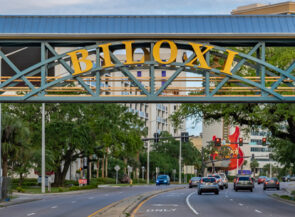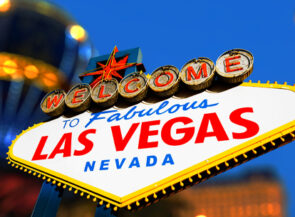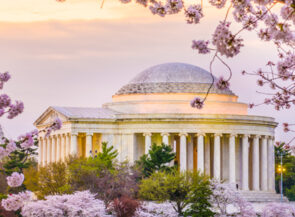With 37 million residents, Tokyo has more people than all of Texas. Its restaurants have more Michelin stars than those of London and Paris combined. It’s one of only 10 cities to host the Olympics more than once. It has the world’s busiest pedestrian intersection (Shibuya Crossing) and train station (Shinjuku Station). It’s famed for being a futuristic playground, yet it possesses 7th-century temples and some of the oldest shops on the planet. (Japan as a whole is home to more than 33,000 businesses that are over 100 years old, some dating to the 6th century.) Despite the scale, scope, and intensity of their city, however, Tokyoites mostly gather in intimate pockets. Forget Lost In Translation; Tokyo offers so many ways to be found in translation.
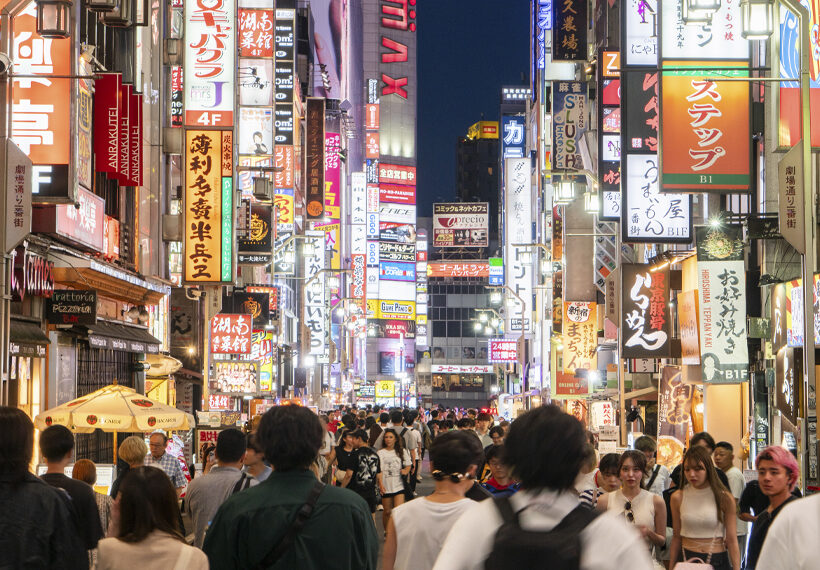
Day 1
A $12 peach, Hayao Miyazaki’s muse, and—surprise!—Tom Hanks
After hopping off the Narita Express from the airport and popping out of Tokyo Station, I experience something unexpected for a newcomer: nostalgia.
Go-karts piloted by folks in Mario, Luigi, and Princess Peach cosplay zoom by. A lagging Bowser, clearly too small for his costume, roars past in their wake. It’s a lot for so early in the morning, but now the joyful Super Mario Bros. anthem is stuck in my head, and I have no complaints.
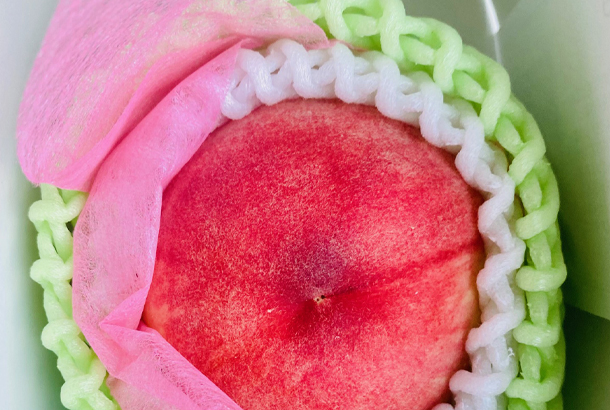
Peach! That reminds me! I dip into the adjacent Kitte Marunouchi mall and do some fancy grocery shopping at Sembikiya, a 189-year-old shop that sells $116 muskmelons, $77 grapes, $74 mangoes, and the only fruit I can afford: a $12 peach. “Don’t eat this today!” warns the clerk as he puts it in a special box. “Wait until the day after tomorrow.” Now ya tell me!
My original breakfast plans thwarted, I head instead to a Tokyo standby: 7-Eleven. Seriously. This is nothing like the Stateside version (no Slurpees!). The food is amazing, especially the sandwiches made with shokupan, an unbelievably fluffy crustless white bread. I grab a mentaiko onigiri (a cod roe–filled triangle of rice wrapped in dried seaweed) and a bottle of cold green tea.
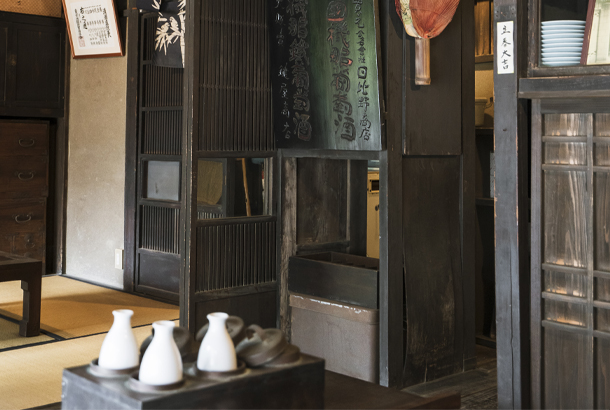
Fortified, I drop my luggage at the Hoshinoya Tokyo before a shake-off-the-jet-lag stroll that ends at the Imperial Palace, which can only be seen from across a moat. I want more, though, so I take a bus to the Edo-Tokyo Open-Air Architectural Museum, an outdoor showcase for vintage architecture. (For rainy days, there’s also the indoor Koto City Fukagawa Edo Museum.) I’m greeted by Yukihiro Abe, the curator, who actually specializes in Japan’s Nara era (roughly 700 CE). He’s been here since 1992, which was my Hypercolor era. The Edo period, which is named after Tokyo’s original moniker, ran from 1603 to 1867, but the museum includes vintage buildings from all eras, including a recreation of a hut from the Jomon period (14,000 to 300 BC). I had expected skyscrapers and bullet trains in Tokyo, but here I am geeking out over an 1850s bar, a 1930s kitchenware shop, and a 1960s streetcar.
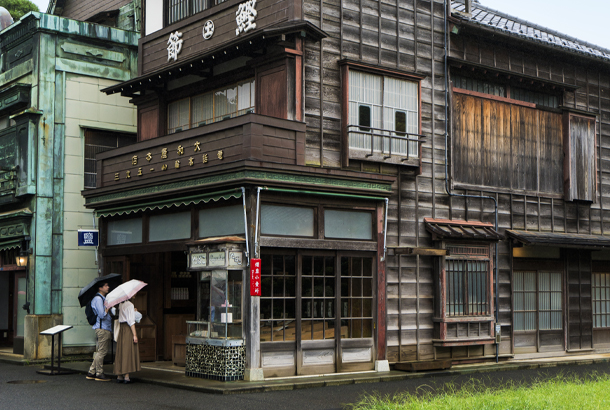
The star of the museum is a cluster of shops that feels pulled out of a Hollywood set, anchored by a 1920s bathhouse. Revered director Hayao Miyazaki used to come here and sketch (he designed the museum’s caterpillar mascot), and the buildings inspired one of his animated masterpieces, Spirited Away. “It inspires in many ways,” Abe says. “The more we know about our past, the more we know about ourselves.”
I couldn’t agree more. My current past is that I didn’t eat enough for breakfast, which lets me know my present self is hungry. Thankfully, one of the vintage shops is still operating as a diner, so I pop in and get a bowl of udon with all the trimmings.
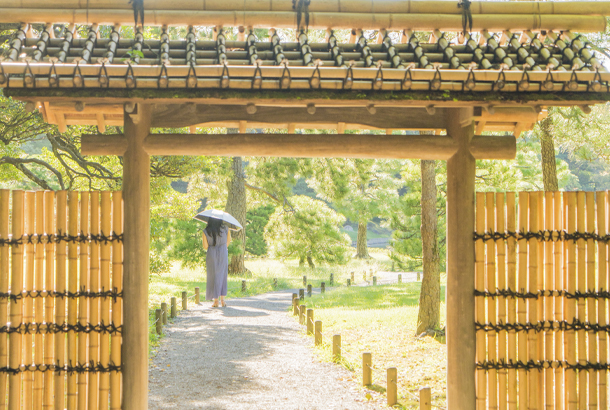
I want to keep this throwback experience going, so it’s on to the Rikugien Gardens, which date back to 1702 and were once owned by the founder of Mitsubishi. In a beautiful act of life imitating art, the gardens are inspired by famous Japanese poems, but I’ve come here to go full circle and make art imitating life, by taking an uchiwa fan-making workshop with Ota Mitsue. A fourth-generation artisan, Mitsue has been making fans for decades and still runs a shop in Chiba. She takes me through all of the steps: splitting the bamboo, fanning it out, gluing on the paper. What amazes me is the range of my fellow students: children, elders, a first date, even three of the park’s gardeners. The Japanese concept of wabi-sabi (the perfection of imperfection) means all of our fans—mine is white with blue flowers—turn out beautiful.
An after-workshop teatime by the garden’s lake sparks my appetite (again), so I make my way to Kanda Matsuya, a soba noodle shop that’s been open since 1884. (Abe told me he knows this restaurant; it’s down the street from the original location of the noodle shop at his museum.)
I get a table for one and am surprised at the menu’s final page, which is just a giant photo of Tom Hanks and several Japanese businessmen, all seemingly teetering between being panicked and beer-buzzed. Apparently, Hanks crashed the joint in 2016 while promoting a movie. It turns out he has great taste. I wolf down three servings of soba: traditional, with shrimp tempura, and with sudachi (a bitter but refreshing Japanese citrus). I leave, only to be chased down by my waitress: I’ve forgotten my fan.
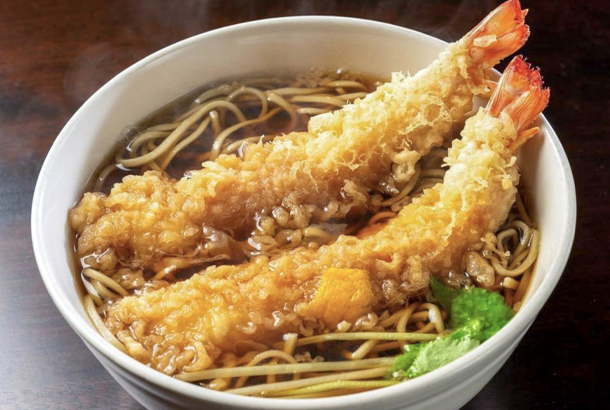
Now, cradling my delicate paper creation, I finally decide to head back to the Hoshinoya. The hotel is styled as a ryokan (a traditional Japanese inn), where guests remove their shoes in the lobby and walk barefoot or in socks everywhere (even in the exquisite restaurant). Each floor has just six rooms, making it feel almost overwhelmingly intimate. It’s not until I attend an evening concert on the second floor, however, that it all hits me.
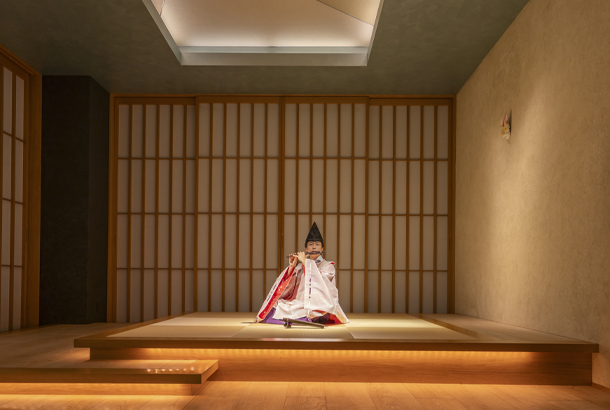
A musician is playing a ryūteki (dragon flute), which has the effect of a grand cathedral’s pipe organ, except she holds it in her hands. Japan was isolationist for centuries, and this concert gives me some idea why: Such uniqueness is worth defending from the tedious sameness that globalization can bring. My first lesson in Japanese is wordless, conveyed through this music: If you hold your traditions carefully enough with your heart, they can stay untouched by time. I’m so enthralled that it takes me a while to realize I’m the only person in attendance not wearing a kimono—even the men. The hotel provides them, but I’m too nervous to try. Instead, I head to the roof and get naked.
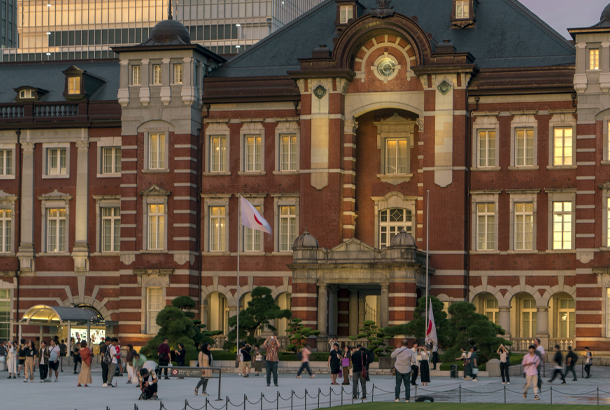
“Don’t be shy!” reads a pamphlet on onsens (hot spring baths). With my lack of shyness on full display, I wade into the rooftop pool, which pipes natural hot water up from below the earth. It’s open-air, and there’s something amazing about having a steamy soak in galactically inky water, shimmering in the moonlight, while taking in the night sky in all of its breezes and lullabies and mysteries and promises. Forget maglev trains; with all its ingenuity, Tokyo found a way to make castles in the sky real.
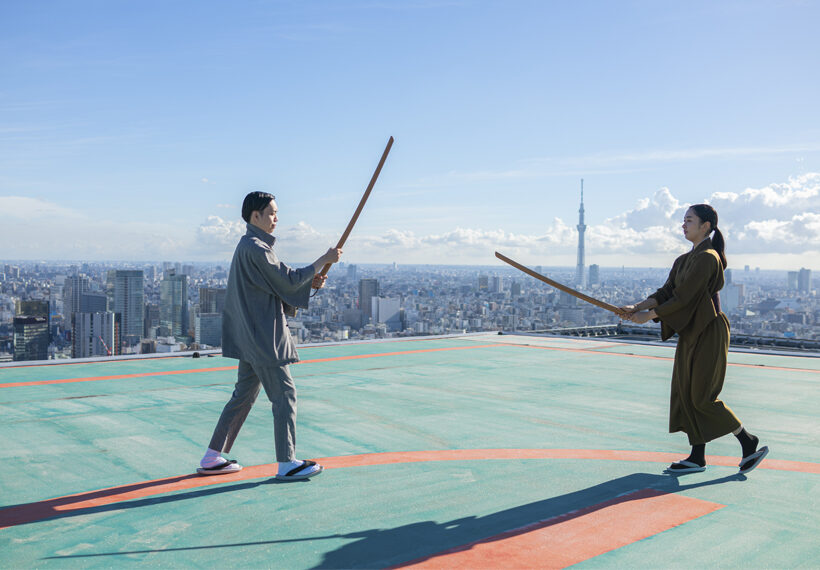
Day 2
Helipad swordplay, a no-shoes-allowed playground, and a sushi star
As a night owl, I should know better than to
go to a country called the Land of the Rising Sun, but here I am, up at dawn, wearing a kimono and wielding a deadly katana (fiiiine, a wooden practice one).
I know it’s daybreak because I’m on a helipad atop a tower next to the Hoshinoya, and sunlight is still spilling out across the sky like a runny egg yolk. Tokyo is full of rooftop experiences, which I had written off as cheesy, but now I understand: With this elevation comes a stirring, humbling awareness of the sheer scope of the city. In every direction, the density of Times Square continues to the horizon.
My instructor teaches me some basic moves, but we mostly focus on breathing exercises. Is kenjutsu (samurai swordplay) just… breathwork for men? Before I can follow that train of thought, my instructor picks up my phone and says what I have been too scared to suggest: This should be a photo shoot. With a giddiness equal parts Jedi and Ninja Turtle, I swing and stab and leap and pose. “I’m sorry if I scared you with my intimidating fighting skills,” I joke afterward. We laugh all the way back to the ground floor.
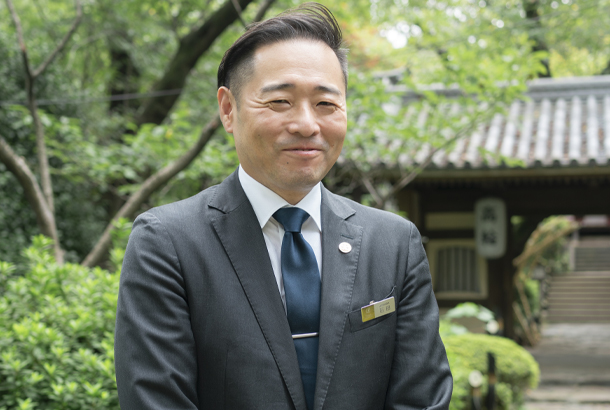
After an oishii (tasty) bento box breakfast in my room, I’m ready to head out. My earlier heli-bravery has given me the courage to ride the Japanese subway. Not that there’s anything to fear; the Yamanote line, a circular track that loops around Tokyo’s core, is ridiculously clean and comfortable. I take it from Tokyo Station to Shinagawa Station and my new hotel, The Prince Sakura Tower Tokyo, Autograph Collection. Here, I get my favorite version of screen time: a picture window with a sweeping skyline view centered by the red-and-white, Eiffel-ish Tokyo Tower, which is so iconic that it has its own emoji. (It helps that emojis were invented in Japan.)
The Sakura Tower is part of a compound of hotels that all share amenities, but it has a secret weapon that lifts it above its neighbors: concierge Junya Ishida, who I nickname Kisai-san (Mr. Genius or Mr. Wizard) for his near-miraculous ability to suggest perfect diversions across the city. Local bars, tiny shops, secret gardens—the list is so tantalizing, I’m saving it for my next trip, too. Before exploring his recommendations, though, I have some super-basic, touristy things I want to do. First, I head to Asakusa, home to the Sensoji, Tokyo’s oldest temple. While this may sound monastic and dusty, it’s one of the coolest pockets of town, featuring a long lane packed with tiny booths selling knick-knacks and wonders. I hate the word “vibrant,” but that’s exactly what Asakusa is.
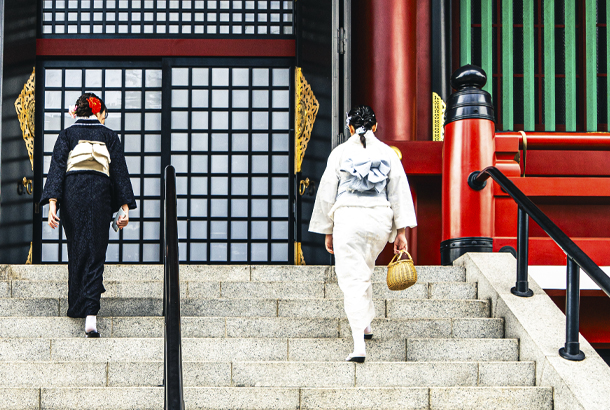
I’m hungry, so I make my way into a mall—I’m not kidding about being basic today—to try Sushiro, the epic à la carte sushi chain where you order on a tablet and the dishes you select ride a conveyor belt right to your seat. As you eat, you keep the plates, which are then tallied for your final bill. The greatest trick of sushi is that it’s one bite and then—for better or worse—it’s over. It’s all or nothing, which encourages culinary derring-do. I order ikura (bulbous orange salmon roe, which I love), but wilder choices too: salmon with mozzarella and basil, shrimp with melted cheese, a pancetta and broccoli roll with something resembling ranch dressing, a cylindrical slice so cluttered and mammoth it’s just called “well-packed sushi roll,” and even a free mystery item billed simply as “currently test marketing.”
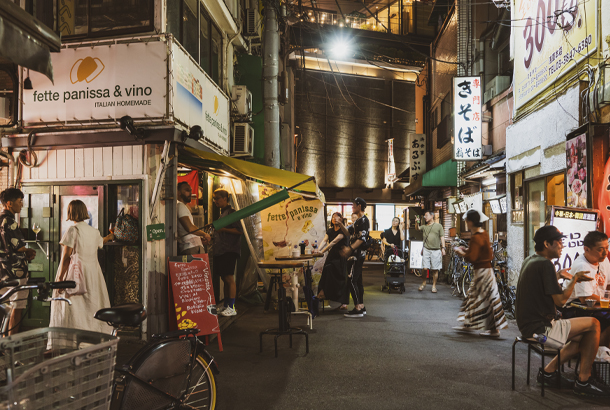
I waddle away and onto the Yurikamome line, a monorail that follows a scenic path through the artificial island of Odaiba. The way the tracks weave effortlessly through the scenery—a boat-shaped cruise terminal, a giant building called Tokyo Big Sight, and, I swear, a miniature Statue of Liberty—is next-level. We cross Rainbow Bridge and the Super Mario music resurfaces in my head.
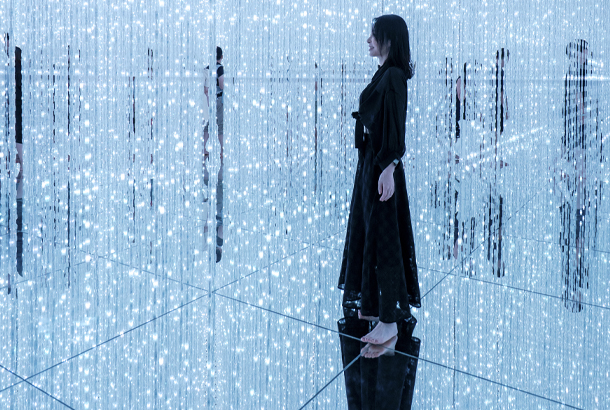
Near the end of the line, I disembark for an experience that feels almost like a video game: the Japanese art collective TeamLab’s newest digital immersion exhibition, Planets. “With your entire body, immerse, perceive, and become one with the art,” instructs a sign that follows up with guidance to remove our shoes and hoist up our trousers, as there will be a few rooms that involve wading through knee-high water.
I venture from room to room and experience—that’s the only word for it—a waterfall, a spongy mountain pass, a chamber of infinite light, a spinning garden, a wading pond full of digital koi… I won’t spoil all the surprises, but it’s the kind of magical playground where you’re having so much fun that you can’t tell who is using their phone for Instagram clout and who is using it to record memories to cherish for a lifetime.
Nothing works up an appetite quite like devoting your entire body to becoming one with art, so I head to dinner at Sushi Mitsukawa, in the flashy Roppongi Hills complex. I feel a little guilty about my lunch—I know sushi can be much more ambitious—so I’m honored to sit down one-on-one with Michelin-starred chef Koji Mitsukawa for a 14-course sushi omakase.
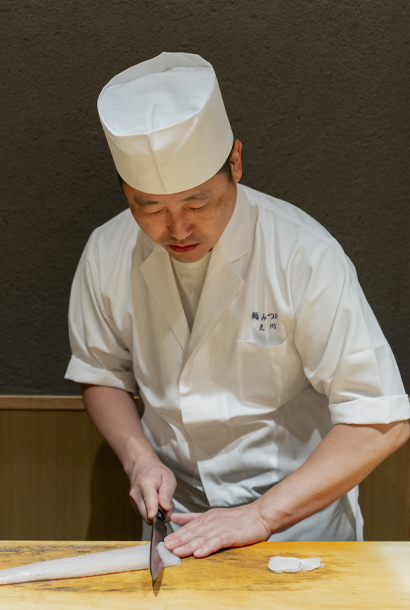
After I devour fat greenling in kombu water, purple sea urchin, and red squid with green perilla, Mitsukawa asks me how it is. He’s surprised by my answer—that it’s frustrating. I explain that as a writer my whole job is to know the right word for the right feeling in the right moment, but his artistry has me at a loss for words. My notes are childish: amazing, sharp, roller-coaster, delicate, perfect. Then I stumble on a word that catches his attention: symphony, referring to thinly sliced horse mackerel with chopped onion, ginger, and scallions. He stifles a chuckle and tells me that when he knew he wanted to become a sushi chef, at 17, he bought a Tchaikovsky CD and listened to it on a loop to learn “where to bring excitement and where to calm down.” I tell him that I’ve met lots of people who can play the piano or violin or guitar, but never anyone who knows how to play the ocean. He bows.
By the end of the meal, I’m reeling. I head up to the Mori Tower Rooftop Sky Deck for some emotional digestion. Funnily, the sound system is playing classical music.
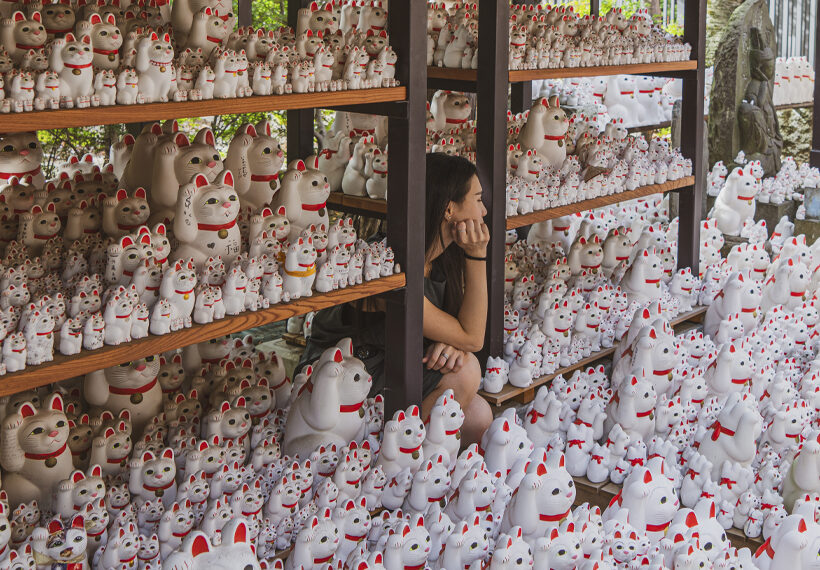
Day 3
A coffee temple, an appeal to the cat gods, and a native nosh
It’s peach day! Finally! The fruit feels like a newborn baby or puppy in my hand, and the only way I can describe its juiciness is that it rains on the floor with every bite. Rains. It’s worth every penny.
I’m starting today with a morning of shopping in Ginza. Of course, this glamour district boasts all the glitzy standbys, but it’s also home to “antenna stores,” which sound like some sort of RadioShack but are actually cultural embassies of Japan’s 47 prefectures—sort of like if California or Wisconsin had a shop of its local goods on Fifth Avenue in New York City. I browse all of Japan: Hiroshima’s momiji manjū (maple leaf–shaped pastries), Ishikawa’s sake, and Okinawa’s pottery. Somehow, though, I still end up at Uniqlo, where I buy a canvas tote and have it emblazoned with my Japanese nephew’s name, in Japanese, as a birthday present. Total cost: $17.
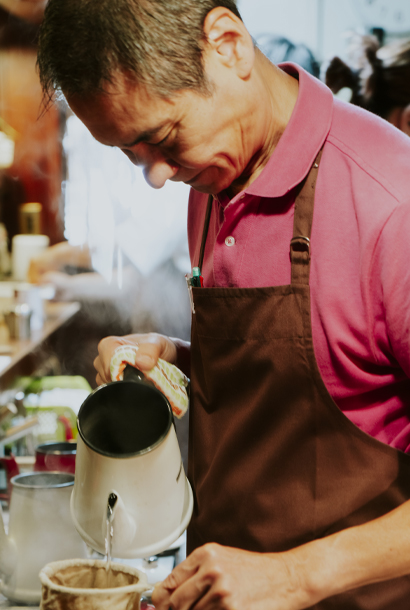
In need of a jolt of energy, I dip into Café de L’Ambre, where I’m greeted by two words: “Just coffee.” I nod and am taken to a small curved bar. The café has barely changed since it opened in 1948. Founder Ichiro Sekiguchi died in 2018, but his apprentice, Fujihiko Hayashi, still mans the coffee pots, as he has since at least 1980. The couple next to me came from Hong Kong just for this brew. As I sip mine, I can’t help thinking that I’m sitting in what’s very likely the world’s best coffee shop.
Caffeinated, I’m inspired to make a solemn, albeit out-of-the-way, quest to Gotokuji, a temple in west Tokyo that’s the home of maneki-neko (those lucky waving cat statues you see everywhere in the world). The temple itself is ordinary (for a temple) but the sight of thousands of identical white cat statues in a display that’s something between a hoarder’s attic and a Terracotta Army is both beautiful and chaotic. I don’t buy a statue myself—although, with eight different sizes, there are budget-friendly options. I just leave a prayer for my cats, Magic and Teaspoons: “Please stop fighting.”

Catastrophe avoided, I head to the Hotel Groove Shinjuku. My room is on the 38th floor of the smack-dab-in-the-middle-of-it-all new Kabukicho Tower. I take a quick cat nap—I’m human!—and wake up hungry. No more artisanal rabbit holes: I want to be full after this lunch, so I pass by Omoide Yokocho, an area full of tiny restaurants that seem romantic but cramped. I’m feeling too gluttonous to be watched by all the passersby, so I return to Ginza, going past the National Kabuki Theater and down an inconspicuous staircase to Iroriya Higashiginzaten for a special dish. (Thanks for the tip, Kisai-san!)
Kobore ikura literally means “so much salmon roe that it’s spilling all over the place.” A great deal of what I’ve experienced in Japan has been subtle and quiet service, but when I order the kobore, a waiter starts pounding a massive drum. Another waiter comes by with a cauldron of ikura and a giant ladle. “Yoisho! Yoisho!” they chant, as 14 ladles of ikura are heaped into my bowl. It’s the Japanese version of “heave ho,” and it’s a dream come true for an ikura-lover like me.
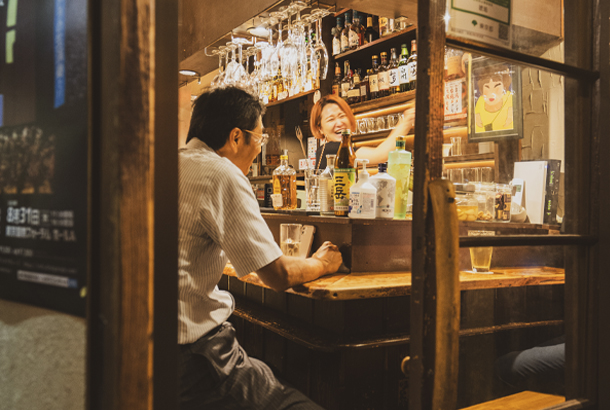
So full of salmon roe that I fear my scent may attract wild bears, I stumble to Golden Gai, a warren of narrow alleys chock full of tiny, wild bars—Kangaroo Court Decision, Deathmatch in Hell, countless others—that serve half a dozen customers at a time. I’m here for… anthropological purposes. A couple of hours later, after learning the word nijikai (after-party), I have chugged so much anthropology that I wobble a bit as I head back to Groove. I pause at Harukor, Tokyo’s only restaurant dedicated to the cuisine of the Ainu (an indigenous group from northern Japan), for an anthropology-absorbing bowl of rice topped with grilled venison. I wash it down with a fuchsia-colored juice made of hasukappu (a native berry that tastes like cherry, cranberry, and pomegranate all at once).
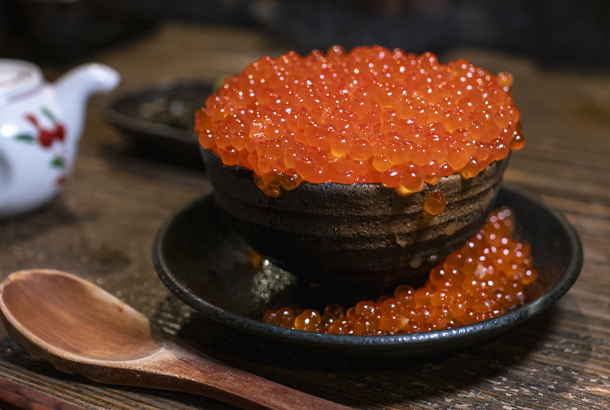
Back in my room, lying in bed, I listen to the lullaby of Shinjuku’s trains below. Tomorrow, I’ll wrap up my trip with a visit to the rooftop onsen at Haneda Airport’s new 24-hour spa before my flight, which, thanks to the time change and the International Date Line, will land in New York before it takes off in Tokyo. That realization drives home the fact that my time here has been fleeting—but also full. A collection of moments: the breeze of a fan, the bounce of a rickshaw, the whoosh of a sword (yes, even a wooden practice sword). All momentous. All momentum. For all its traditions, Tokyo has an extraordinary power to change at a moment’s notice. With a happy sigh, I give it another moment.
Tokyo, Two Ways: United offers daily nonstop service to both airports in Tokyo from Los Angeles, New York/ Newark, and San Francisco. There are also nonstop flights to Tokyo Haneda from Chicago O’Hare and Washington, D.C., and nonstop flights to Tokyo Narita from Denver, Houston Intercontinental, Guam, and Saipan.


